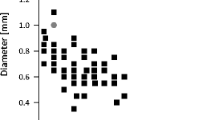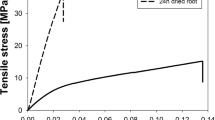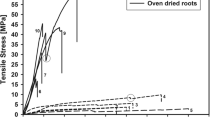Abstract
Background and aims
Data on cyclic root mechanical behaviour (i.e. roots subjected to repeated loading and unloading cycles at a given frequency) are lacking. In this study, cyclic root mechanical traits were measured.
Methods
Chrysopogon zizanioides L. roots were sampled for monotonic and cyclic tensile tests. The effects of pre-cyclic loading on the monotonic mechanical properties (n = 92) and reversal strains on any changes in cyclic mechanical properties (n = 88) were measured. The root water content and root traits, including diameter, dry density, and specific root length (SRL), were also measured for each sample.
Results
Pre-cyclic loading at 5% and 50% strain levels reduced the root tensile strength (Tr) by 18.17% and 27.10%, respectively, yet increased the breakage strain (εr) by 30.85% and 52.13%, respectively. Although Tr and the Young’s modulus (E) were reduced after cyclic loading, the trend of their correlations with root diameter (i.e. negative power law correlation) was unaffected. Remarkable hysteresis was found in any loading cycle. The hysteresis loop size and peak tensile stress decreased abruptly during the first 20 cycles. The peak tensile stress explained more than 86% of the variability of Young’s modulus along the unloading path at all the reversal strains.
Conclusion
The root mechanical traits obtained from monotonic tests should not be used to explain the root reinforcement in cyclic events because of cyclic-induced changes in the Tr and E. Regardless of the strain range experienced in a cyclic event, determining the changes in root mechanical properties during the first 20 regular cycles of loading is crucial.











Similar content being viewed by others
Data availability
The data that supports the findings of this study are available from the first and corresponding authors upon reasonable request.
Change history
28 October 2023
A Correction to this paper has been published: https://doi.org/10.1007/s11104-023-06335-6
Abbreviations
- \(d\) (mm):
-
Root diameter
- \(e\) (mm∙mm−1):
-
Root elongation at breakage
- \(f\) (Hz):
-
Loading frequency
- \(l\) (mm):
-
Root gauge length
- \({l}_{t}\) (mm):
-
Total length of the root sample
- \({m}_{a}\) (g):
-
Weight of root sample before testing
- \({m}_{d}\) (g):
-
Root dry weight
- \({m}_{f}\) (g):
-
Weight of root sample after testing
- \(v\) (mm∙mm−1):
-
Loading/unloading rate
- \({v}_{d}\) (mm−3):
-
Root dry volume
- \(w\) (g∙g−1):
-
Root water content
- \({A}_{i}\) (Pa∙m):
-
Area of hysteresis loop at ith cycle
- \(E\) (MPa):
-
Young’s modulus
- \({E}_{r}\) (MPa):
-
Modulus after being loaded of 50 cycles
- \({E}_{load}\) (MPa):
-
Young’s modulus of loading cycle
- \({E}_{load,i}\) (MPa):
-
Young’s modulus of ith loading cycle
- \({E}_{unload}\) (MPa):
-
Young’s modulus of unloading cycle
- \({E}_{unload,i}\) (MPa):
-
Young’s modulus of ith loading cycle
- \(F\) (N):
-
Tensile force
- \(SRL\) (m∙g−1):
-
Specific root length
- \({T}_{p}\) (MPa):
-
Peak tensile stress
- \({T}_{pi}\) (MPa):
-
Peak tensile stress at ith cycle
- \({T}_{r}\) (MPa):
-
Tensile strength
- \(\varDelta A\) (MPa):
-
Difference in the area of hysteresis loop between the first and 50th cycles
- \({\varDelta E}_{load}\) (MPa):
-
Difference in Young’s modulus along the loading cycle between the first and 50th cycles
- \({\varDelta E}_{load}\) (MPa):
-
Difference in Young’s modulus along the unloading cycle between the first and 50the cycles
- \({\varDelta T}_{p}\) (MPa):
-
Difference in peak tensile stress between the first and 50th cycles
- \({\varepsilon }_{b}\) (mm∙mm−1):
-
Root estimated root breakage strain
- \({\varepsilon }_{r}\) (mm∙mm−1):
-
Root breakage strain
- \({\rho }_{d}\) (g∙mm−3):
-
Root dry density
References
Akoglu H (2018) User’s guide to correlation coefficients. Turkish J Emerg Med 18(3):91–93. https://doi.org/10.1016/j.tjem.2018.08.001
Asane D, Schmitz A, Wang Y, Sugano S (2020) A study on the elongation behaviour of synthetic fibre ropes under cyclic loading. In 2020 IEEE/RSJ International Conference on Intelligent Robots and System (IROS) pp 6326–6331. IEEE. https://doi.org/10.1109/IROS45743.2020.9341407
Aslani F, Jowkarmeimandi R (2012) Stress–strain model for concrete under cyclic loading. Mag Concr Res 64:673–685. https://doi.org/10.1680/macr.11.00120
Badhon FF, Islam MS, Al-Hussaini TM (2019) Study of root-reinforcement effect on shear strength parameters of soil obtained by direct shear tests. In: Proceedings, international conference on disaster risk mitigation. Dhaka, Bangladesh
Badhon FF, Islam MS, Islam MA (2021) Contribution of vetiver root on the improvement of slope stability. Indian Geotech J 51:829–840. https://doi.org/10.1007/s40098-021-00557-0
Belaadi A, Bezazi A, Bourchak M, Scarpa F (2013) Tensile static and fatigue behaviour of sisal fibres. Mater Des 46:76–83. https://doi.org/10.1016/j.matdes.2012.09.048
Boldrin D, Bengough AG, Lin Z, Loades KW (2021) Root age influences failure location in grass species during mechanical testing. Plant Soil 461:457–469. https://doi.org/10.1007/s11104-020-04824-6
Boldrin D, Leung AK, Bengough AG (2017) Root biomechanical properties during establishment of woody perennials. Ecol Eng 109:196–206. https://doi.org/10.1016/j.ecoleng.2017.05.002
Boldrin D, Leung AK, Bengough AG (2018) Effects of root dehydration on biomechanical properties of woody roots of Ulex europaeus. Plant Soil 431:347–369. https://doi.org/10.1007/s11104-018-3766-7
Burgert I (2006) Exploring the micromechanical design of plant cell walls. Americal J Bot 93:1391–1401. https://doi.org/10.3732/ajb.93.10.1391
Chiatante D, Sarnataro M, Fusco S, Di Iorio A, Scippa G (2003) Modification of root morphological parameters and root architecture in seedlings of Fraxinus ornus L. and Spartium junceum L. growing on slopes. Plant Biosystems 137:47–55. https://doi.org/10.1080/11263500312331351321
Cislaghi A (2021) Exploring the variability in elastic properties of roots in Alpine tree species. J for Sci 67(7):338–356. https://doi.org/10.17221/4/2021-JFS
Cislaghi A, Cohen D, Gasser E, Bischetti GB, Schwarz M (2019) Field measurements of passive earth forces in steep, shallow, landslide-prone areas. J Geophys Res: Earth Surf 124(3):838–866. https://doi.org/10.1029/2017JF004557
Cofie P, Koolen A, Perdok UJ (2000) Measurement of stress–strain relationship of beech roots and calculation of the reinforcement effect of tree roots in soil–wheel systems. Soil Tillage Res 57:1–12. https://doi.org/10.1016/S0167-1987(00)00126-4
Commandeur PR, Pyles MR (1991) Modulus of elasticity and tensile strength of Douglas-fir roots. Can J For Res 21(1):48–52. https://doi.org/10.1139/x91-007
Comino E, Marengo P, Rolli V (2010) Root reinforcement effect of different grass species: a comparison between experimental and models results. Soil Tillage Res 110:60–68. https://doi.org/10.1016/j.still.2010.06.006
De Baets S, Poesen J, Reubens B, Wemans K, Baerdemaeker JD, Muys B (2008) Root tensile strength and root distribution of typical mediterranean plant species and their contribution to soil shear strength. Plant Soil 305:207–226. https://doi.org/10.1007/s11104-008-9553-0
Dumlao MR, Ramananarivo S, Goyal V, DeJong JT, Waller J, Silk WK (2015) The role of root development of Avena fatua in conferring soil strength. Am J Bot 102:1050–1060. https://doi.org/10.3732/ajb.1500028
Eab KH, Likitlersuang S, Takahashi A (2015) Laboratory and modelling investigation of root-reinforced system for slope stabilisation. Soils Found 55:1270–1281. https://doi.org/10.1016/j.sandf.2015.09.025
Eichenhofer M, Wong JC, Ermanni P (2018) Exploiting cyclic softening in continuous lattice fabrication for the additive manufacturing of high performance fibre-reinforced thermoplastic composite materials. Compos Sci Technol 164:248–259. https://doi.org/10.1016/j.compscitech.2018.05.033
Genet M, Stokes A, Salin F, Mickovski SB, Fourcaud T, Dumail J-F, van Beek R (2005) The influence of Cellulose content on tensile strength in tree roots. Plant Soil 278:1–9. https://doi.org/10.1007/s11104-005-8768-6
Giadrossich F, Schwarz M, Cohen D, Cislaghi A, Vergani C, Hubble T, Phillips C, Stokes A (2017) Methods to measure the mechanical behaviour of tree roots: a review. Ecol Eng 109:256–271. https://doi.org/10.1016/j.ecoleng.2017.08.032
Hany NF, Hantouche EG, Harajli MH (2015) Axial stress-strain model of CFRP-confined concrete under monotonic and cyclic loading. J Compos Constr 19:04015004. https://doi.org/10.1061/(ASCE)CC.1943-5614.0000557
Kamchoom V, Leung AK, Boldrin D, Sakolpanya T, Wu Z, Likitlersuang S (2022) Shearing behaviour of vegetated soils with growing and decaying roots. Can Geotech J 59:2067–2084. https://doi.org/10.1139/cgj-2021-0695
Karimzadeh AA, Leung AK, Fardad Amini P (2022a) Energy-based assessment of liquefaction resistance of rooted soil. J Geotech Geoenvironmental Eng ASCE 148(1):06021016–06021011. https://doi.org/10.1061/(ASCE)GT.1943-5606.0002717
Karimzadeh AA, Leung AK, Gao Z (2022b) Shear strength anisotropy of rooted soils. Geotechnique Ahead of Print. https://doi.org/10.1680/jgeot.22.00103
Karimzadeh AA, Leung AK, Hosseinpour S, Wu Z, Fardad Amini P (2021) Monotonic and cyclic behaviour of root-reinforced sand. Can Geotech J 58:1915–1927. https://doi.org/10.1139/cgj-2020-0626
Launay A, Maitournam M, Marco Y, Raoult I, Szmytka F (2011) Cyclic behaviour of short glass fibre reinforced polyamide: experimental study and constitutive equations. Int J Plast 27:1267–1293. https://doi.org/10.1016/j.ijplas.2011.02.005
Leung AK, Kamchoom V, Ng CWW (2017) Influences of root-induced soil suction and root geometry on slope stability: a centrifuge study. Can Geotech J 54:291–303. https://doi.org/10.1139/cgj-2015-0263
Liang T, Knappett J, Duckett N (2015) Modelling the seismic performance of rooted slopes from individual root–soil interaction to global slope behaviour. Geotechnique 65(12):995–1009. https://doi.org/10.1680/jgeot.14.P.207
Liu SS, Li J, Ji XD, Fang Y (2022) Influence of root distribution patterns on soil dynamic characteristics. Sci Rep 12(1):13448.z. https://doi.org/10.1038/s41598-022-17828-2
Loades KW, Bengough AG, Bransby MF, Hallett PD (2013) Biomechanics of nodal, seminal and lateral roots of barley: effects of diameter, waterlogging and mechanical impedance. Plant Soil 370:407–418. https://doi.org/10.1007/s11104-013-1643-y
Loades K, Bengough A, Bransby M, Hallett P (2015) Effect of root age on the biomechanics of seminal and nodal roots of barley (Hordeum vulgare L.) in contrasting soil environments. Plant Soil 395:253–261. https://doi.org/10.1007/s11104-015-2560-z
Makarova OV, Cofie P, Koolen AJ (1998) Axial stress–strain relationships of fine roots of Beech and Larch in loading to failure and in cyclic loading. Soil Tillage Res 45(1–2):175–187. https://doi.org/10.1016/S0933-3630(97)00017-2
Mao Z (2022) Root reinforcement models: classification, criticism and perspectives. Plant Soil 472(1–2):17–28. https://doi.org/10.1007/s11104-021-05231-1
Mao Z, Roumet C, Rossi LM, Merino-Martín L, Nespoulous J, Taugourdeau O, Bouk-cim H, Fourtier S, Rey-Granado MD, Ramel M, Ji K, Zuo J, Fromin N, Stokes A, Fort F (2023) Intra‐and inter‐specific variation in root mechanical traits for twelve herbaceous plants and their link with the root economics space. Oikos 2023(1):e09032. https://doi.org/10.1111/oik.09032
Mao Z, Saint-Andréb L, Genetc M, Mined F-X, Jourdanb C, Reye H, Courbaudf B, Stokes A (2012) Engineering ecological protection against landslides in diverse mountain forests: choosing cohesion models. Ecol Eng 45:55–69. https://doi.org/10.1016/j.ecoleng.2011.03.026
Mao Z, Wang Y, McCormack ML, Rowe N, Deng XB, Yang XD, Xia SW, Nespoulous J, Sidle RC, Guo DL, Stokes A (2018) Mechanical traits of fine roots as a function of topology and anatomy. Ann Botany 122(7):1103–1116. https://doi.org/10.1093/aob/mcy076
Meijer GJ (2021) A generic form of fibre bundle models for root reinforcement of soil. Plant Soil 468:45–65. https://doi.org/10.1007/s11104-021-05039-z
Meijer GJ, Bengough AG, Knappett JA, Loades KW, Nicoll BC (2018) In situ measurement of root reinforcement using corkscrew extraction method. Can Geotech J 55:1372–1390. https://doi.org/10.1139/cgj-2017-0344
Mukaka MM (2012) A guide to appropriate use of correlation coefficient in medical research. Malawi Med J 24(3):69–71
Ng CWW, Leung AK, Ni JJ (2019) Plant-soil slope interaction, 1st edn. CRC Press
Niklas KJ, Spatz HC (2010) Worldwide correlations of mechanical properties and green wood density. Am J Bot 97(10):1587–1594. https://doi.org/10.3732/ajb.1000150
O’sullivan M, Ritchie R (1993) Tree stability in relation to cyclic loading. Forestry 66:69–82. https://doi.org/10.1093/forestry/66.1.69
Phan TN, Likitlersuang S, Kamchoom V, Leung AK (2021) Root biomechanical properties of Chrys-opogon zizanioides and Chrysopogon nemoralis for soil reinforcement and slope stabilisation. Land Degrad Dev 32(16):4624–4636. https://doi.org/10.1002/ldr.4063
Saifuddin M, Osman N (2014) Evaluation of hydro-mechanical properties and root architecture of plants for soil reinforcement. Curr Sci 107(5):845–852
Saito M (1983) Direct tensile fatigue of concrete by the use of friction grips. In Journal Proceedings, pp 431–438. https://doi.org/10.14359/10867
Schwarz M, Rist A, Cohen D, Giadrossich F, Egorov P, Büttner D, Stolz M, Thormann JJ (2015) Root reinforcement of soils under compression. J Geophys Research: Earth Surf 120(10):2103–2120. https://doi.org/10.1002/2015JF003632
Shi G, Wang M, Bai Y, Wang F, Shi Y, Wang Y (2012) Experimental and modeling study of high-strength structural steel under cyclic loading. Eng Struct 37:1–13. https://doi.org/10.1016/j.engstruct.2011.12.018
Shi Y, Wang M, Wang Y (2011) Experimental and constitutive model study of structural steel under cyclic loading. J Constr Steel Res 67:1185–1197. https://doi.org/10.1016/j.jcsr.2011.02.011
Sonnenberg R, Bransby MF, Hallet PD, Bengough AG, Mickovski SB, Davies MCR (2010) Centrifuge modelling of soil slopes reinforced with vegetation. Can Geotech J 47:1415–1430. https://doi.org/10.1139/T10-037
Stokes A, Douglas GB, Fourcaud T, Giadrossich F, Gillies C, Hubble T, Kim JH, Loades KW, Mao Z, McIvor IR, Mickovski SB, Mitchell S, Osman N, Phillips C, Poesen J, Polster D, Preti F, Raymond P, Rey F, Schwarz M, Walker LR (2014) Ecological mitigation of hillslope instability: ten key issues facing researchers and practitioners. Plant Soil 377:1–23. https://doi.org/10.1007/s11104-014-2044-6
Taylor RN (1995) Geotechnical centrifuge technology, 1st edn. CRC Press
Tosi M (2007) Root tensile strength relationships and their slope stability implications of three shrub species in the Northern Apennines (Italy). Geomorphology 87(4):268–283. https://doi.org/10.1016/j.geomorph.2006.09.019
Truong PNV, Loch R (2004) Vetiver system for erosion and sediment control. In: Proceeding of 13th international soil conservation organization conference, pp 1–6
Vergani C, Werlen M, Conedera M, Cohen D, Schwarz M (2017) Investigation of root reinforcement decay after a forest fire in a Scots pine (Pinus sylvestris) protection forest. For Ecol Manag 400:339–352. https://doi.org/10.1016/j.foreco.2017.06.005
Wang K, Brennan A, Knappett J, Robinson S, Bengough A (2018) Centrifuge modelling of remediation of liquefaction-induced pipeline uplift using model root systems. Physical modelling in Geotechnics. CRC Press, pp 1265–1270. https://doi.org/10.1201/9780429438646
Wu Z, Leung A, Boldrin D, Ganesan SP (2021) Variability in root biomechanics of Chrysopogon zizanioides for soil eco-engineering solutions. Sci Total Environ 776:145943. https://doi.org/10.1016/j.scitotenv.2021.145943
Xu S, Wang S, Liu H, Zhang Y, Li L, Soares CG (2021) Experimental evaluation of the dynamic stiffness of synthetic fibre mooring ropes. Appl Ocean Res 112:102709. https://doi.org/10.1016/j.apor.2021.102709
Yang Y, Chen L, Li N, Zhang Q (2016) Effect of root moisture content and diameter on root tensile properties. PLoS ONE 11:e0151791. https://doi.org/10.1371/journal.pone.0151791
Zhou YQ, Brown N (1992) The mechanism of fatigue failure in a polyethylene copolymer. J Polym Sci Part B: Polym Phys 30:477–487. https://doi.org/10.1002/polb.1992.090300507
Zhou F, Li L (2016) Experimental study on hysteretic behavior of structural stainless steels under cyclic loading. J Constr Steel Res 122:94–109. https://doi.org/10.1016/j.jcsr.2016.03.006
Zhu J, Wang Y, Wang Y, Mao Z, Langendoen EJ (2019) How does root biodegradation after plant felling change root reinforcement to soil? Plant Soil 446:211–227. https://doi.org/10.1007/s11104-019-04345-x
Acknowledgements
The authors gratefully acknowledge the grants provided by the Hong Kong Research Grant Council (GRF/16202720, CRF/C6006-20G and N_HKUST603/22) and the National Natural Science Foundation of China (NSFC) (grant no. 51922112). The third author (David Boldrin) acknowledges the financial support by the EPSRC project (EP/R005834/1) “Climate Adaptation Control Technologies for Urban Spaces (CACTUS)” and The James Hutton Institute, which receives funding from the Rural & Environment Science & Analytical Services Division of the Scottish Government.
Author information
Authors and Affiliations
Contributions
AL and DB conceived the research idea. ZW designed and conducted the experiments and produced the first draft of the paper. AL contributed to writing the paper. DB commented the paper.
Corresponding author
Ethics declarations
Conflict of interest
The authors declare that they have no known competing financial interests or personal relationships that could have appeared to influence the work reported in this paper.
Additional information
Responsible Editor: Zhun Mao.
Publisher’s Note
Springer Nature remains neutral with regard to jurisdictional claims in published maps and institutional affiliations.
Supplementary Information
Below is the link to the electronic supplementary material.
ESM 1
(DOCX 168 KB)
Rights and permissions
Springer Nature or its licensor (e.g. a society or other partner) holds exclusive rights to this article under a publishing agreement with the author(s) or other rightsholder(s); author self-archiving of the accepted manuscript version of this article is solely governed by the terms of such publishing agreement and applicable law.
About this article
Cite this article
Wu, Z., Leung, A.K. & Boldrin, D. Mechanical responses of Chrysopogon zizanioides roots under cyclic loading conditions. Plant Soil 494, 437–459 (2024). https://doi.org/10.1007/s11104-023-06289-9
Received:
Accepted:
Published:
Issue Date:
DOI: https://doi.org/10.1007/s11104-023-06289-9




